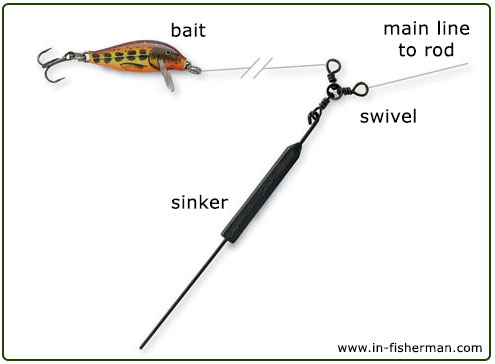
The Three Way Rig and Stream Rig are most commonly drifted or trolled in river or current situations to keep the bait a set distance off the bottom.
The primary difference between the two setups is that the Stream Rig is more of a finesse setup than the Three Way Rig and it is typically used with lighter line, smaller hooks and less weight.
-
Suggested Seasonal Use: Year-round, open water
-
Species: Primarily walleye, catfish, trout, salmon and bass, though other river and current-oriented species may be caught
-
How to Rig: The Three Way (Wolf River) Rig features a three-way swivel to connect the main line with a section of baited leader material, and another section of line to which a sinker is attached. Typically a bell, casting or egg sinker is used for weight.
The Stream (Drift) Rig, is identical in design but utilizes split shot weights rather than a single bell, casting or egg sinker. Both hooked live bait or artificial lures, such as crankbaits, may be used with either of these rigs.
-
How to Use: One key to finding success with the Three Way Rig is to find the proper amount of weight to keep good contact with the bottom, but not so much that you end up continuously breaking off and having to re-tie. Some anglers also recommend using a lighter pound-test line material to connect your weight to the three-way swivel. When hung up, the lighter line allows for just the weight to break off rather than the entire rig.
The Stream Rig can be a more effective approach for situations with lighter current or shallower water. Like many other setups, the Stream Rig is commonly baited with night crawlers, minnows, egg sacks and cut bait. One key to fishing this lighter rig is to maintain constant feel of the line as it ticks along the bottom. Its subtleness is one of its greatest strengths, but it also requires greater concentration and feel from anglers in order to differentiate bottom contact from an actual bite.
